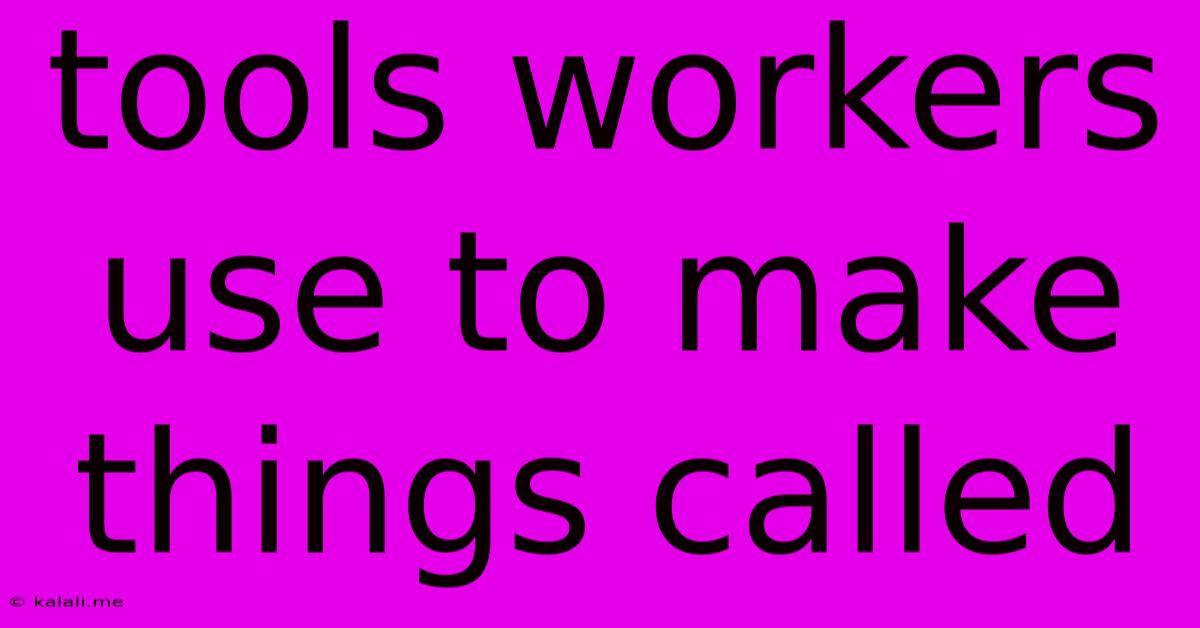Tools Workers Use To Make Things Called
Kalali
May 23, 2025 · 4 min read

Table of Contents
Tools Workers Use to Make Things: A Comprehensive Guide
Meta Description: Discover the diverse array of tools used by skilled workers across various industries, from basic hand tools to sophisticated machinery, and understand their crucial role in manufacturing and construction. This guide explores everything from hammers and saws to CNC machines and 3D printers.
The world of manufacturing and construction relies heavily on the ingenuity and precision of skilled workers, and their ability to create is only as good as the tools at their disposal. From the simplest carpentry projects to the most complex engineering feats, the right tools are essential for efficiency, safety, and quality. This article provides a comprehensive overview of the vast array of tools workers use to make things, categorizing them for clarity and highlighting their key applications.
Hand Tools: The Foundation of Craftsmanship
Hand tools form the bedrock of many trades. These tools are typically powered manually and are versatile enough for a wide range of tasks. Examples include:
- Measuring Tools: Rulers, tape measures, calipers, and levels are crucial for accurate measurements and ensuring precise work. Accuracy in these initial steps is critical for the final product.
- Cutting Tools: Saws (hand saws, hacksaws, circular saws – even if power-assisted, they often rely on manual guidance), chisels, knives, and planes are used to shape and cut materials. The choice of tool depends heavily on the material being worked.
- Striking Tools: Hammers, mallets, and punches are used for driving nails, shaping metal, or breaking apart materials. Different types of hammers are designed for specific applications and material types.
- Fastening Tools: Screwdrivers, wrenches, and pliers are used to assemble and secure components. Specific types cater to different screw heads and bolt sizes.
- Other Essential Hand Tools: Files, rasps, scrapers, and clamps are used for shaping, smoothing, and holding materials in place during construction or repair.
Power Tools: Amplifying Human Capabilities
Power tools significantly enhance efficiency and precision, enabling workers to complete tasks more quickly and accurately than with hand tools alone. They are powered by electricity, compressed air, or internal combustion engines. Key examples include:
- Drilling Tools: Drills (both cordless and corded) are used for creating holes in various materials, and are essential for many assembly and construction projects. Specialized bits allow for different hole sizes and shapes.
- Cutting Tools: Power saws (circular saws, reciprocating saws, miter saws, jigsaw), routers, and grinders greatly speed up cutting and shaping processes. Safety precautions are paramount when using these tools.
- Sanding Tools: Belt sanders, orbital sanders, and random orbital sanders are used for smoothing surfaces and achieving fine finishes. Different grits of sandpaper allow for varying levels of smoothness.
- Other Power Tools: Impact wrenches, nail guns, and various specialized power tools exist for specific tasks, significantly increasing productivity.
Advanced Manufacturing Tools: Precision and Automation
Modern manufacturing relies heavily on sophisticated tools and machinery that enable mass production and highly precise work. This category includes:
- CNC Machines (Computer Numerical Control): These automated machines precisely cut, shape, and mill materials based on pre-programmed instructions. They are crucial for high-precision parts manufacturing.
- 3D Printers: Additive manufacturing using 3D printers allows for the creation of complex shapes and prototypes with relative ease. This technology is revolutionizing many industries.
- Robotics: Robots are used for repetitive tasks, welding, painting, and assembly in automated manufacturing processes, boosting efficiency and consistency.
- Laser Cutters: These tools utilize lasers for precise cutting and engraving of various materials, ideal for intricate designs and detailing.
Specialized Tools: Tailored for Specific Trades
Many trades require tools specifically designed for their unique needs. For example, plumbers use pipe wrenches and threading tools, electricians use wire strippers and crimpers, and welders use welding torches and safety equipment. The list of specialized tools is extensive and highly dependent on the trade.
This overview provides a glimpse into the vast and evolving world of tools used by skilled workers. The constant innovation in tool design continues to improve efficiency, safety, and the quality of work across various industries, reflecting the ongoing evolution of human ingenuity and our ability to shape the world around us. Understanding these tools is crucial for appreciating the skill and dedication involved in creating the things we use every day.
Latest Posts
Latest Posts
-
Installing Ceiling Fan On Vaulted Ceiling
May 25, 2025
-
Six Legged Black And Orange Bug
May 25, 2025
-
How To Get Rid Of Bounty Skyrim
May 25, 2025
-
On One Hand Or On The One Hand
May 25, 2025
-
Double Pole 30 Amp Breaker For Dryer
May 25, 2025
Related Post
Thank you for visiting our website which covers about Tools Workers Use To Make Things Called . We hope the information provided has been useful to you. Feel free to contact us if you have any questions or need further assistance. See you next time and don't miss to bookmark.